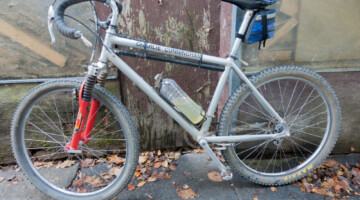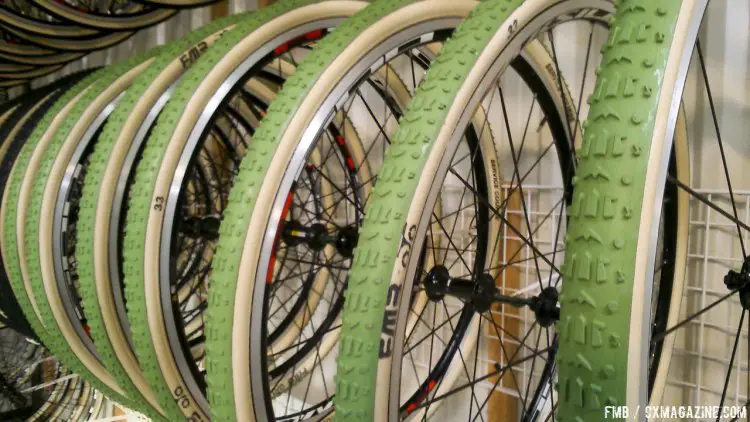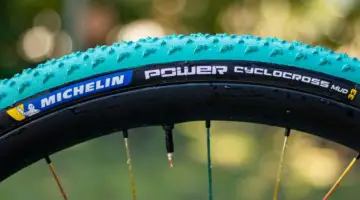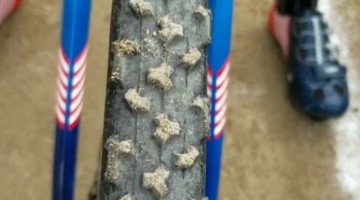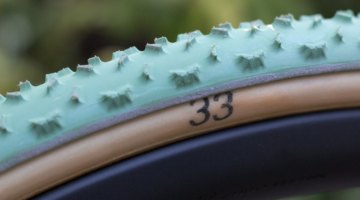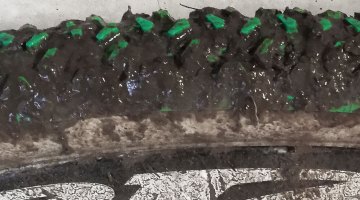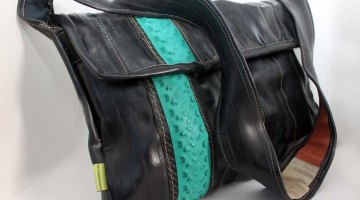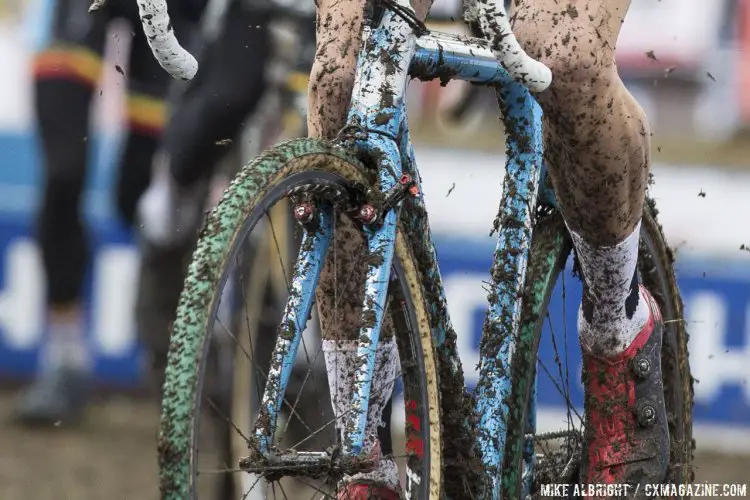
Wout van Aert raced Niels Albert’s old Michelin Mud-treaded Dugast tubulars at the 2015 Cyclocross World Championships. © Mike Albright / Cyclocross Magazine
What’s Old is New
Wout van Aert surprised many at the 2015 Cyclocross World Championships in Tabor by racing a pair of Neils Albert’s old original Michelin Mud treads glued to Dugast tubular casings. Michelin’s famous mint green tires haven’t been produced in almost 15 years, but the silica-based green rubber was touted to have good grip in wet conditions, and the tall knobs, generous volume and open tread provided made the tire a winner. The downside was the tread wore down faster than traditional carbon black-based rubber. (Van Aert wasn’t the only one to experiment with tires in Tabor, as Sven Nys also played with new rubber compounds used in his Dugast Rhino tubulars).
Despite wearing quite quickly, the now-vintage Michelin Mud tires developed quite a following that’s survived 15 years after production has stopped. The green Mud clinchers even famously replaced Tim Johnson’s tubulars on some snowy, muddy days. The clinchers are still are coveted, and NOS tires can sometimes claim more than $100 per tire on eBay.
You No Longer Have to Be Green With Envy
FMB Tires, the small France-based handmade tubular tire company, is now out to satiate the green, silica cyclocross tire coveters with a new green rubber that will be offered this year. The photo above shows FMB’s newest tread, the all-conditions Slalom, developed with Katie Compton and unveiled last summer, in a brand new green silica rubber. It’s a color that will remind old-timers more of the old green Vittoria Mastercross and Tigre treads, rather than the Michelin Mud clinchers.
What’s so special about silica? Silica is nothing new to bike or automobile tires. It’s used prominently in bicycle tires from companies like Michelin and Continental, and even used in Michelin’s current black Mud 2 cyclocross tire made with Michelin’s Energy rubber.
Silica first appeared in bike tires in 1995, in Michelin’s Hi-Lite Bi-Synergic road tire, and silica vendors tout its unique ability to both reduce rolling resistance and improve wet weather performance and traction. But as they say, there’s no such thing as a free lunch, and in the past silica was used to optimize one, but at the expense of the other. Silica, a component of sand, can replace the softer carbon black used in rubber, and the typically harder compound can reduce hysteresis (energy loss due to deformation) and therefore increase efficiency, especially in auto and road bike tires.
The harder compound can also roll better on hard surfaces, but historically would wear faster and decrease traction in wet conditions. But rubber technology has improved over the last two decades, and Michelin, at least for automobile tires, has reportedly found a good balance between rolling resistance, wear and durablity, and offers this compound in its Michelin Energy Saver tires that it claims to save gas, stop shorter and wear longer.
FMB’s silica rubber for its cyclocross tubulars, as we saw with the original Michelin Mud tires, will be optimized for wet and cold weather traction, even if they do wear faster than a black tread. FMB’s Francois Marie told Cyclocross Magazine, “the new new rubber compound with the silica, [will keep] the adhesion of the rubber with low temperatures.” This sounds similar to what Nys was testing in Tabor.
The tires, although not yet advertised on the FMB website, are shipping soon, according to Marie. Stay tuned as we’ll be testing an early set.
More info: www.fm-boyaux.fr









